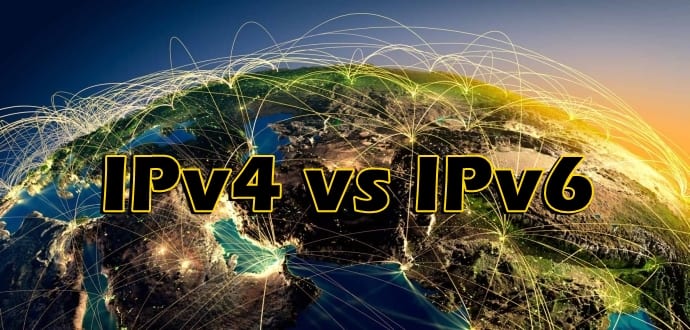Difference Between IPv4 and IPv6
As an avid internet user, one is bound to have come across the terms IPv4 and IPv6 along with the debate about why the world needs to shift over to IPv6. An average joe at this point probably knows about the debate and why the jump is needed, but what exactly is the difference between the 2 protocols ?
Back Story
IPv4 today, is one of the core protocols of standard based inter-networking methods in the internet. It was initially deployed along with ARPANET back in 1983. IPv4 as we know has a limit to the number of address with the ceiling being hit at 4.3 billion addresses owing to addresses in it being in 32-bits. While 4.3 billion was a lot when it was deployed, the internet has gone through a volcanic eruption of devices in the era of the smartphone. The number of devices capable of connecting to the internet were restricted to Personal Computers until the year 2000 and 4.3 billion addresses was more than enough for all the computers in the world. With the availability of the smartphone however, every person now owned at least 2 devices that could connect to the internet thus doubling the number of addresses needed almost instantly.
With this boom of internet usage, also came the very real demand of more IP address and that’s when the world truly understood the need for IPv6. While IP address were limited to being four 1 byte numbers in IPv4, the newer version used 128 bits for IP address thus making them go from (192.168.1.1) to (fe80::d4a8:6435:d2d8:d9f3b11). Even a layman can see the vast increase in the number of characters available and more characters means more addresses.
The Differentiation
This was the basic stuff that everyone knows but that’s not all there is when we talk about difference. IPv4 used Dynamic Host Configuration Protocol (DHCP) to configure an IP address every time it connects to the world wide web. IPv6 supports a revised DHCPv6 protocol that supports stateful auto-configuration, and supports stateless auto-configuration of nodes. This type of configuration utilizes router advertisements to generate a unique address. This ability creates a plug and play type of environment, where one can simply connect to the web and the address will be automatically generated on the go. There is a lot more differences between the two protocol version that we have listed below
| IPv4 | IPv6 |
|---|---|
| Packet size : 576 bytes required, fragmentation is optional | Packet size : 1280 bytes required fragmentation not needed |
| Packet fragmentation : Routers and sending hosts | Packet fragmentation : Sending hosts only |
| IPv4 was not designed with the intention of security – Originally designed for an isolated military network – Then adapted for a public educational & research network |
IPv6 was designed ground up with strong security – Encryption – Authentication |
| IPv4 header has 20 bytes. IPv4 header has many fields (13 fields) |
IPv6 header is the double, it has 40 bytes. IPv6 header has fewer fields, it has 8 fields. |
| ISP have IPv4 connectivity or have both IPv4 and IPv6 | Many ISP don’t have IPv6 connectivity |
| Non equal geographical distribution (>50% USA) | No geographic limitation |

But which protocol is more powerful in terms of internet speed